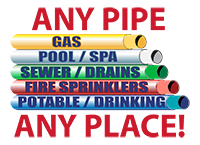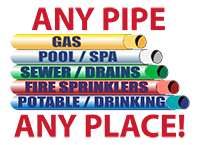Irrigation pipes often carry water that isn’t pure, and may even be corrosive. Sometimes producers rely on wastewater or process water to irrigate their crops. In addition, they might add chemicals and other harsh products to the water. Although the chemicals provide a valuable service to the crops, they often lead to damage and/or deterioration to the irrigations pipes. Once damage and corrosion occur in the pipeline, it puts your valves, heads and any mechanical devices at risk.
A polyethylene pipeliner prevents damage caused by chemicals and contaminated water. It protects the pipe from corrosion and keeps your valves, heads and mechanical devices safe too. If you rely on the use of corrosive water or the addition of chemicals, a polyethylene line will result in safer, more resilient irrigation pipes.
Pool and Spa Pipes
A pool adds fun, a way to exercise, and another level of luxury to your home. In spite of a seemingly simple system, sometimes the pool or its drain pipe system fails. If your pool keeps losing water, resulting in constant refills, it’s probably due to cracks and leaks in the drain pipes. Suddenly, your biggest luxury is causing you more stress. If you choose to have the drain pipes replaced, matters could get worse instead of better.
Digging up the drain pipes for replacement is often destructive. Most contractors dig up your property to get to the pipe location. Indoor pools are an even bigger job as there is more in the way between the pool and the drain pipe.
A trenchless pipe liner is a much more efficient solution. There’s no need to dig up your yard or go through your floors and walls. The plumbers feed the lining into the existing drain and let it cure. This creates a secure pipe within the pipe that is corrosion-resistant and leak-free.
Pond Pipes
Ponds are a beautiful addition to any landscape, whether they provide an aesthetic or functional purpose. Most pond pipes run underground from an off-site water source. Pipelining is a practical solution for repairing pond pipes that become damaged over time.
Fountain Pipes
You know the delight that children and adults get from watching sculpture water fountains deliver water in fun and imaginative ways. The pipelines that supply the water run in opposing directions beneath the sculpture, sometimes creating a complex sculpture of pipes below. Some operate using suction while others rely on pressure. These pipes also vary in diameter, ranging from two to fifteen inches. Fountain sculpture pipes are made from iron, PVC, or cast iron.
Over time, the piping gets worn and becomes thinner. Some pipes, such as those made of ductile iron, are susceptible to corrosion. The exposure to chemicals and detergents in the water causes the pipe to develop cracks. The interior walls of the pipe grow rough, causing the interior space to shrink. This begins the cycle of rust, mold, and mildew development that damages the structure of the sculpture. As the corrosion increases, so do the leaks, flooding, and sinkholes resulting from the pipe damage.
The process for restoring the sculpture fountain starts with an evaluation of the condition of the pipeline. A pipelining process can restore the pipes and provide a resilient surface to the inside of the pipe walls. If there is a lot of corrosion or rust, the pipe may require cleaning prior to applying the lining. Pipelining is a simple solution that doesn’t require you to dig up the fountain to get to the pipes. It also lasts for a long time and keeps the fountain sculpture free of damage.
If your irrigation pipes or any water delivery system isn’t working optimally, contact San Diego Plumbing and Pipelining. We have the answers and solutions to all of your pipe repair and replacement needs.










